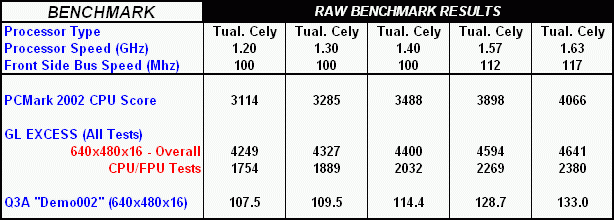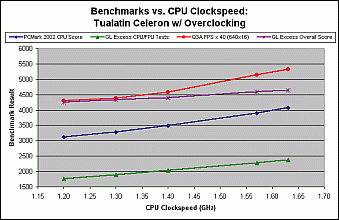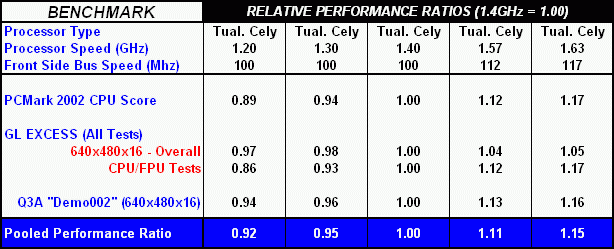| MORE NUMBERZ.... |
The first table shows the raw data, which I will leave the reader to peruse. Probably of more value in interpretation of the data is the chart that follows. As expected, the benchmark results all trend upward with increasing processor clockspeed (duh!). But one thing to note is the apparent increase in slope seen at the two overclocked processor speeds for a couple of the benchmarks. Presumably, this is due to the fact that the FSB clock boost speeds up other things in the PC, and not just the CPU clock. So, at least in some cases, the results are a bit higher than would be expected if only the processor speed was increasing.
 |
 |
|
| Click on chart to enlarge |
The final table uses the same relative performance comparison that was employed on the previous page. However, here I've used the non-overclocked 1.4GHz processor result as the normalizing factor, to make the effect of overclocking as clear as possible. As you can see, the impact of raising the processor clockspeed via FSB adjustment is nearly 1-to-1. The 12% overclock delivers an overall boost of 11% in the benchmarks, and the 17% FSB jump gives a 15% increase. This further substantiates that more is going on here than just a CPU speed increase, since we would only expect about half of that impact, based on previous data. The increase in system bus speed--not unexpectedly--has a broader effect than just increasing the CPU clock.

| FINAL COMMENTS, CONCLUSIONS & MISCELLANEOUS BLATHERING.... |
The addition of the new 1.4GHz Tualatin Celeron to the PowerLeap product line further extends the CPU speed options for the BX system upgrader. While the original 1.2GHz model offers the best speed-for-the-dollar, I suspect most prospective upgraders will probably opt to spend the extra $20 and go for the top of the line. And being about 20% faster than the P3-1GHz for $9 less, that seems like a pretty good deal! The 1.4GHz isn't a great overclocker, but appears to be capable of reaching the mid-1.6GHz range for those with systems that have adjustable FSB speeds. But I've had the 1.2GHz Celeron up nearly that high, so overclockers may find that "slower" version even more attractive. And the "rev.2" iP3/T is a definite step forward, with its better heatsink/fan and core voltage adjustment jumpers.
The question comes up from time to time, "I have a P3-1GHz at the moment--should I upgrade to the 1.4GHz Celeron rig?" Frankly, it's hard to justify spending $170 for a ~20% performance boost. However, if you can sell that P3 for a decent price, or can "hand it down" to another slower PC, it may still make sense for you. That's a personal call that has to be made by the reader. I'm just trying to present the data here that can help with such a decision.
But if you're still running an old 100MHz FSB Deschutes P2 or one of the early Katmai P3's and want something faster, then you owe it to yourself to head over to the PowerLeap website and check out the offerings. As long as you have a compatible system board (they have a whole database on that subject!), the iP3/T and Tualatin Celeron can put a real charge in that old PC!
|
June 21, 2002
Questions or comments? E-mail me at THIS LINK |
|
